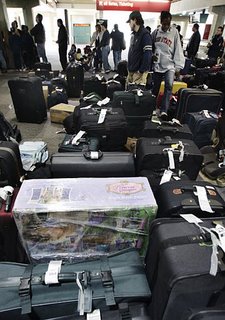Old Baggage
I love it when I think of a good business idea and someone has done it already.
I always carry my bags with me on the plane, mostly because I can't stand arriving early to check bags and then waiting after a long flight for my bags to arrive after I do. Besides, the airlines have a terrible reputation for losing bags. Or for sending them the wrong place.
I used to fly from Boston to London and I always was routed through JFK. At JFK, the airline failed every time to get my bag from the plane arriving from Logan to the plane departing to Heathrow. To its credit, the airline always got the bag on the very next flight.
I took advantage of this. When my luggage failed to arrive with me at Heathrow, I got a $100 voucher. I checked into my room, bought $100 of clothes, and submitted my voucher before the airline's London office closed at 1pm on a Saturday. I always flew in on a Saturday so I could catch a show Saturday night and get over jet lag before starting work on Monday. Predictable inconvenience, it turns out, is much more lucrative than unpredictable inconvenience.
My business idea? Why, a luggage service, of course. You would have two sets of luggage or two trunks. One would go to your next destination, the other would go to the destination after that. In between, magically someone would clean all the clothes. It would be possible to travel indefinitely while carrying only a book or an iPod on board to entertain yourself.
 Since August 10th last year, when Scotland Yard discovered a plot to blow up trans-Atlantic jets and alerted us to the danger of carrying bottles of aftershave on board, passengers have checked more and more bags. Consequently, the airlines have lost more and more bags. 35 million last year.
Since August 10th last year, when Scotland Yard discovered a plot to blow up trans-Atlantic jets and alerted us to the danger of carrying bottles of aftershave on board, passengers have checked more and more bags. Consequently, the airlines have lost more and more bags. 35 million last year.If airlines put RFID tags on your luggage, they could track your bags as well as FedEx. Besides the infrastructure costs, RFID tracking would add about $1.00 to the cost of every checked bag. If the market is working efficiently, it probably costs the airlines less than $1.00 per checked bag to compensate passengers for bags that are lost. As with many other insurance type problems, the incentives are backwards for getting airlines to solve the problem. Cheaper to payoff the bag losers than fix the problem.
What can you do? If you check your bags, two things: 1) tag inside & outside, and 2) photograph everything. Luggage handling machines remove luggage tags the same way dry cleaning machines break the buttons on your shirts. These machines should never work that way, but they do. So, put a tag on the inside of your bag in case the machines munch the tag on the outside.
If you own a digital camera, take a picture of everything. Make snaps of your luggage (quick ... can you describe what your luggage looks like?), the luggage tags, and even what's inside your bags. Why? Well, luggage thieves more often take things out of your bag than take your entire bag. They're smart enough to know the value of your underwear. If you have pictures of what was in your bag, you have a better chance of recovering your losses whether you lost your bag or someone took things out of it.
I still like my business idea. The poor man's version is called FedEx. You can have FedEx pick up your bags and deliver them to your hotel. Expensive? What does it cost you in lost time if you carry your own bags and lost money if your luggage ends up somewhere else or gets lost?
An emerging idea is to add other value add services on top of FedEx. If you're feeling a little heavy in the wallet, take a look at services like The Virtual Bellhop and Luggage Concierge. Pricing for these services work like FedEx: overnight delivery is more expensive than 2-day, etc. What I haven't found is the service that cleans in between, but I'm sure these companies would consider providing cleaning for the right payment.
Here's a fun video on emerging technology for baggage handling.


